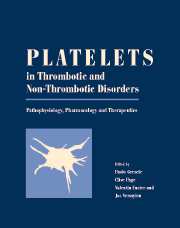Book contents
- Frontmatter
- Contents
- List of contributors
- Editors' preface
- PART I PHYSIOLOGY
- PART II METHODOLOGY
- PART III PATHOLOGY
- 34 Hereditary thrombocytopenias
- 35 Thrombocytopenias due to bone marrow disorders
- 36 Immune-mediated thrombocytopenia
- 37 Thrombocytopenia in childhood
- 38 Alloimmune thrombocytopenia
- 39 Drug-induced and drug-dependent immune thrombocytopenias
- 40 Thrombotic thrombocytopenic purpura and hemolytic uremic syndrome
- 41 Thrombocytosis and thrombocythemia
- 42 Platelet adhesive protein defect disorders
- 43 Congenital disorders of platelet secretion
- 44 Congenital platelet signal transduction defects
- 45 Acquired platelet function defects
- 46 Platelet storage and transfusion
- 47 Pathophysiology of arterial thrombosis
- 48 Platelets and atherosclerosis
- 49 Platelet involvement in venous thrombosis and pulmonary embolism
- 50 Gene regulation of platelet function
- 51 Platelets and bacterial infections
- 52 Interactions of viruses and platelets and the inactivation of viruses in platelet concentrates prepared for transfusion
- 53 Platelets and parasites
- 54 Platelets and tumours
- 55 Platelets and renal diseases
- 56 Platelets and allergic diseases
- 57 Platelet interactions with other cells related to inflammatory diseases
- 58 Platelets and the preimplantation stage of embryo development
- 59 Platelets in psychiatric and neurological disorders
- 60 Platelets in inflammatory bowel disease
- PART IV PHARMOLOGY
- PART V THERAPY
- Afterword: Platelets: a personal story
- Index
- Plate section
51 - Platelets and bacterial infections
from PART III - PATHOLOGY
Published online by Cambridge University Press: 10 May 2010
- Frontmatter
- Contents
- List of contributors
- Editors' preface
- PART I PHYSIOLOGY
- PART II METHODOLOGY
- PART III PATHOLOGY
- 34 Hereditary thrombocytopenias
- 35 Thrombocytopenias due to bone marrow disorders
- 36 Immune-mediated thrombocytopenia
- 37 Thrombocytopenia in childhood
- 38 Alloimmune thrombocytopenia
- 39 Drug-induced and drug-dependent immune thrombocytopenias
- 40 Thrombotic thrombocytopenic purpura and hemolytic uremic syndrome
- 41 Thrombocytosis and thrombocythemia
- 42 Platelet adhesive protein defect disorders
- 43 Congenital disorders of platelet secretion
- 44 Congenital platelet signal transduction defects
- 45 Acquired platelet function defects
- 46 Platelet storage and transfusion
- 47 Pathophysiology of arterial thrombosis
- 48 Platelets and atherosclerosis
- 49 Platelet involvement in venous thrombosis and pulmonary embolism
- 50 Gene regulation of platelet function
- 51 Platelets and bacterial infections
- 52 Interactions of viruses and platelets and the inactivation of viruses in platelet concentrates prepared for transfusion
- 53 Platelets and parasites
- 54 Platelets and tumours
- 55 Platelets and renal diseases
- 56 Platelets and allergic diseases
- 57 Platelet interactions with other cells related to inflammatory diseases
- 58 Platelets and the preimplantation stage of embryo development
- 59 Platelets in psychiatric and neurological disorders
- 60 Platelets in inflammatory bowel disease
- PART IV PHARMOLOGY
- PART V THERAPY
- Afterword: Platelets: a personal story
- Index
- Plate section
Summary
Introduction
Platelet–bacterial interactions contribute to the pathogenesis of hematological infections. Interactions may occur directly with platelets, resulting in bacterial invasion or induction of platelet aggregation. Bacterial invasion of platelets is a key feature of Rickettsial and Ehrlichial infections. Induction of platelet aggregation in vivo, resulting in formation of mural thrombi on heart valves in infective endocarditis, appears to be a response to certain infecting bacteria. During bacteremia or sepsis, platelet microaggregates form and thrombocytopenia is observed. The propensity for bacterial cells to trigger platelet aggregation and thrombosis in vivo suggests concomitant procoagulant activation. Procoagulant activity can also be up-regulated by bacterial products, such as lipopolysaccharides (LPS) and expression of thrombin-like enzymes, resulting in the incorporation of platelets into aggregates or thrombi. Conversely, certain bacteria express toxins and other proteases that will inhibit platelet function or cause platelet lysis and contribute to coagulopathy. More than 30 species of bacteria show platelet activating or inhibitory functions, many of which have been documented to occur during naturally occuring infection in mammals or in experimental animal or human models. This chapter will present examples of platelet dysfunction that results from clinical infections, followed by an examination of partnered bacterial ligands and platelet receptor or targets, and will conclude with a survey of key mechanistic models of platelet–bacterial interactions.
That bacteria in the blood interact with circulating platelets has been recognized since early in the last century (see review by Clawson).
- Type
- Chapter
- Information
- Platelets in Thrombotic and Non-Thrombotic DisordersPathophysiology, Pharmacology and Therapeutics, pp. 781 - 806Publisher: Cambridge University PressPrint publication year: 2002
- 1
- Cited by



